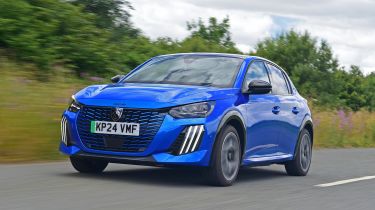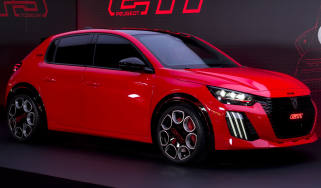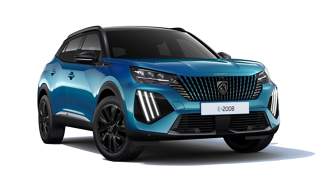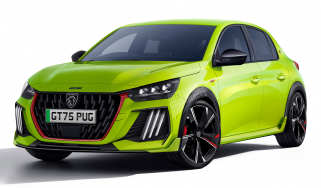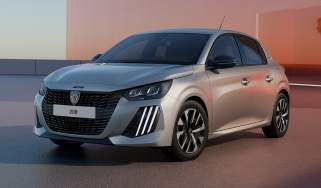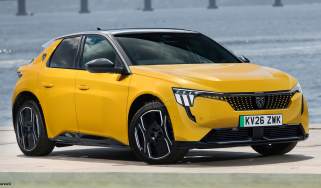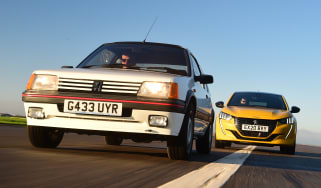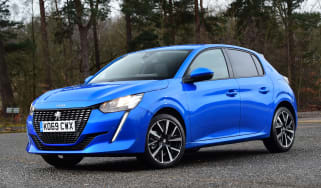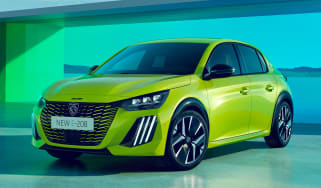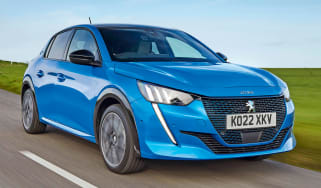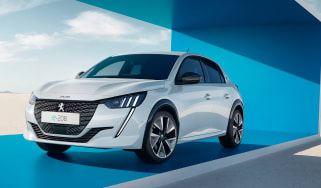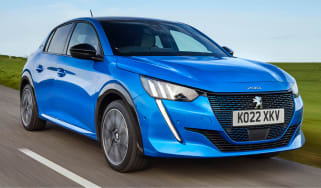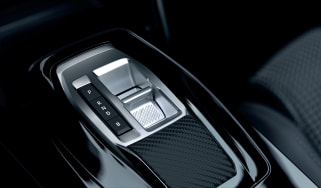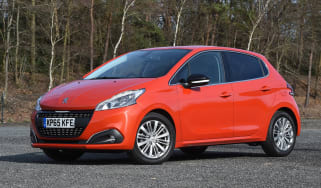Peugeot 208 review
The Peugeot 208 has eye-catching looks and is pleasant to drive, but rivals are more practical and offer better value

Our opinion on the Peugeot 208
Small cars like the Peugeot 208 are synonymous with the brand and the French nation. The latest version sports sharp looks inside and out, carved out from the similarly sporty appearances of other contemporary Peugeots. This helps the 208 stand out in the crowded supermini market. It also rides well, so there is some substance to go with that style.
The latest 208 isn't perfect – interior space is a little compromised in the rear, and it doesn’t have the biggest boot in the class. It’s also more expensive than some of its key rivals, but the 208 does offer buyers a decent level of choice, with four trim levels and a spread of petrol and mild-hybrid engines. There’s always the option of the electric E-208, too.
| Key specs | |
| Fuel type | Petrol, hybrid |
| Body style | Supermini |
| Powertrain |
1.2-litre, 3cyl, turbocharged petrol, front-wheel drive 1.2-litre, 3cyl petrol plus MHEV, front-wheel drive |
| Safety | Four-star Euro NCAP (2019) |
| Warranty | Three-years/60,000 miles |
About the Peugeot 208
Peugeot has some terrific small cars in its back catalogue, most notably the Peugeot 205, a huge success across Europe in the 1980s and ‘90s. The company went off the boil a bit thereafter, and although Peugeot has produced respectable numbers of subsequent cars, nothing has hit the spot in quite the same way. Part of the problem has been a lack of design flair, which the brand has done a lot to address in recent years.
Used - available now
The focus on style really came to the fore in 2016 when Peugeot introduced the second-generation Peugeot 3008 SUV, which effectively redefined its design language. Follow-up models have included the glamorous Peugeot 508 fastback and the fashionable Peugeot 2008 compact SUV, both of which have won plaudits for their style, upmarket feel and pleasant driving characteristics.
But it’s the supermini sector where Peugeot really had to get serious. It’s a core battleground for the French marque and one of the toughest around, with a range of excellent rivals that include the Skoda Fabia, Volkswagen Polo, Renault Clio and MINI Cooper. Peugeot knew it had a fight on its hands, and to its credit, the latest 208 has the chops to take the fight to all of them.
Mixing with the best is one thing, but beating them is another, and it’s a big ask for Peugeot to return from the fight as a champion. Peugeot needed to ensure that comfort and refinement, decent driving dynamics, strong efficiency and plenty of technology were all present in the 208 if it truly wanted to shake up the supermini sector, and in many respects, it has succeeded.
Not only does the Peugeot 208 still have a traditional petrol engine option, but it is following the trend for electrification across the whole car industry by offering a couple of mild-hybrid engine options with increased fuel efficiency. For those wishing to forgo fossil fuels entirely, there’s also the fully electric E-208. You can read our dedicated in-depth Peugeot E-208 review here…
Peugeot 208 buyers have the choice of four trim levels; Style, Allure, GT and GT Premium. The entry-level Style trim was added to the line-up in 2025, and brought the 208’s starting price down by around £5,000.
Key features of Style trim:
- LED headlights
- 16-inch steel wheels with ‘MONTI’ trim
- Cloth upholstery with orange stitching
- Single-zone climate control
- Electric and heated door mirrors
- Rear parking sensors
Key features of Allure trim:
- 16-inch alloy wheels
- Tri-material upholstery
- Front and rear USB-C chargers
- Front and rear parking sensors
- Electronic parking brake
- Privacy glass
Key features of GT trim:
- 17-inch alloy wheels
- Adaptive LED headlights
- Reversing camera
- Gloss black exterior highlights
- Passenger seat height adjustment
- Ambient interior lighting
Key features of GT Premium trim:
- Alcantara upholstery
- Heated front seats
- Navigation and Vision Pack
- Drive Assist Pack Plus
Every 208 is fitted with Peugeot's i-Cockpit dashboard setup. This unusual design incorporates a small steering wheel with the driver’s display located at the top, and while it isn’t necessarily a bad layout, it is a divisive one. We highly recommend trying before you buy.
As for propulsion, the petrol model is built around the prolific 1.2-litre PureTech three-cylinder engine. The turbocharged 99bhp unit isn’t exactly a powerhouse, but it is able to cope with the odd motorway run. Pure petrol power is only available with a six-speed manual gearbox.
Two mild-hybrid versions, 99bhp and 134bhp, come exclusively with a six-speed, dual-clutch automatic transmission. These models are capable of well over 50mpg on the WLTP combined cycle.
If you’re looking into the Peugeot 208, there’s a strong chance that the pure-electric version of the car has piqued your interest. The least powerful E-208 offers a range of up to 225 miles from a 50kWh (46.3kWh usable) battery. There’s also a larger capacity, 51kWh (48.1kWh usable) battery and more powerful electric motor, boosting the small electric car’s official range to 248 miles. If you’re tempted by this zero-emission supermini, be sure to read our in-depth Peugeot E-208 review.
If you’d rather stick with petrol or mild-hybrid power and would like a Peugeot 208 of your very own, our Find a Car service is here to help. You can configure your ideal Peugeot 208 and receive top offers from our dealer network, browse the very latest Peugeot 208 leasing deals or look at plenty of top used Peugeot 208 models. Need to sell your current car? Look no further than our Sell My Car page.
Performance & driving experience
|
Pros |
|
| Cons |
|
There’s plenty of clever tech underpinning the Peugeot 208. It’s every inch the modern supermini, and that’s because the car is based on the CMP platform, something it shares with the Vauxhall Corsa under the Stellantis umbrella.
The 208 and Corsa also use the same engine technology, which is a good thing. The 1.2-litre three-pot PureTech unit is a gem with very little low-down turbo lag. There’s a real fizz to the way it spins up to the red line and, unlike in the old 208, the motor doesn’t make itself heard too much. The six-speed manual feels quite vague and rubbery, though, and it's the only gearbox you can have with a petrol 208. If you need an automatic version, you’ll need to go for the mild-hybrid.
The 208’s suspension absorbs bumps well and remains settled over undulations most of the time. It strikes a good balance by delivering just enough comfort at motorway speeds, without compromising its handling on twistier roads, where the Peugeot feels tauter than the Renault Clio.
One thing worth noting is that the driving modes (Normal, Sport, and Eco) have a far more dramatic impact on the driving experience of electric E-208 models compared with the regular 208. That’s because you only get full motor power in E-208 when using Sport mode. In all other modes, the car limits power to increase efficiency and range.
Performance, 0-60mph acceleration and top speed
Predictably, the 1.2-litre 99bhp petrol is better described as leisurely rather than fiery with an official 0-62mph sprint time of 10.1 seconds, and a maximum speed of 117mph.
The small amount of electrical assistance from the 99bhp mild-hybrid 1.2 model helps it to get off the line more swiftly, completing the 0-62mph sprint in 9.8 seconds. This model will then go on to a top speed of 118mph. The swiftest 208 is the 134bhp mild-hybrid, which covers the 0-62mph dash in 8.1 seconds. This car also has a higher top speed of 127mph.
Town driving, visibility and parking
The 208’s light steering means tight manoeuvres won’t require much physical effort, but the steering wheel’s tiny size and unusual shape can feel a bit strange at times. There were points where we lost track of the front wheels’ position during testing, and this can be especially problematic when attempting to parallel park.
The rear windscreen is also on the smaller side, and this naturally takes its biggest toll when attempting to reverse at certain angles.
When moving in a straight line, the 208’s ride can get a bit jarring over potholes at lower speeds, but on the whole, it remains compliant enough to keep occupants happy.
B-road driving and handling
While the latest 208 is a step on from what went before, it still doesn’t have the agility and sharpness of some of the better handling superminis, such as the SEAT Ibiza. Its steering feel is a little too light for our taste, and it weighs up inconsistently at higher speeds for us to fully feel confident with it.
There’s a decent amount of grip, though, and it behaves in a predictable manner – even if you lift off the accelerator mid-corner in an attempt to unsettle it. Overall, it's a safe car suited to urban and sensible B-road driving. We’d never describe it as being especially fun to drive, though.
Motorway driving and long-distance comfort
A slight lack of excitement is the cost you’ll pay for the Peugeot 208’s decent composure on longer motorway trips. The mild-hybrids offer enough to shove to keep up with traffic and overtake without undue stress, and the ride quality remains calm, making this one of the better superminis for long journeys and commutes.
| Model | Power | 0-62mph | Top speed |
| Style 1.2L PureTech 100 | 99bhp | 10.1s | 117mph |
| GT Hybrid 110 e-DSC6 | 99bhp | 9.8s | 118mph |
| GT Premium Hybrid 145 e-DSC6 | 134bhp | 8.1s | 127mph |
“The 208’s refinement is among the best in its class, and as such, engine and road noise – particularly the knocks and bangs from the suspension – are superbly muted.” - Alex Ingram, chief reviewer.
MPG & running costs

|
Pros |
|
|
Cons |
|
As with most superminis, the Peugeot 208 is designed with urban commutes and shorter journeys (although it copes well with motorways, too). With this in mind, the petrol models will probably suit you best. They’re cheaper to buy and economical enough to make sense as an overall package.
With an official WLTP combined fuel economy of up to 58.2mpg and 127g/km of CO2 emissions, the petrol 208 isn’t too far behind its mild-hybrid siblings. The 99bhp mild-hybrid has a headline figure of 65.9mpg, while the more powerful 134bhp model drops ever so slightly to 60mpg on the dot.
Unsurprisingly, the mild-hybrids do have a slight edge over the petrol in terms of emissions, producing up to 116 and 117g/km, respectively. The key downside of these models is that they cost around £1,500 more to purchase, and it’ll take a little while to recoup this additional expense through fuel savings.
| Model | MPG | CO2 | Insurance group |
| Style 1.2L PureTech 100 | 58.2mpg | 114g/km | 22E |
| GT Hybrid 110 e-DSC6 | 65.9mpg | 105g/km | 23E |
| GT Premium Hybrid 145 e-DSC6 | 62.8mpg | 105g/km | 23E |
Electric range, battery life and charge time
If you think an electric car fits into your lifestyle, it’s certainly worth considering the E-208, even in spite of the list price hike over petrol and mild-hybrid versions of the French marque’s supermini.
The 134bhp, 50kWh battery version offers an official WLTP range of up to 225 miles, which is a useful amount more than the 190 miles of the entry-level MINI Cooper E, and is ideal for many short commutes and even some longer drives if needed. The more powerful 154bhp, 51kWh version will boost the E-208's range up to 258 miles.
During our testing in warmer weather, the more potent E-208 managed an efficiency figure of 4.3 miles per kilowatt hour, giving it a real-world range based on the usable battery capacity of 219 miles. You will need to add the optional heat pump if you plan on taking longer trips in colder winter months. Without it, your range figure has the potential to plummet because a heat pump provides a more efficient way to heat the interior in winter weather.
The similar battery sizes mean that both versions of E-208 can be fully charged from a 7kW home wallbox in 7.5 hours, while a 10 to 80 per cent top-up from a 100kW DC rapid charger will take about 30 minutes.
Those range and charging speed numbers are competitive, but an MG4 can be had with greater battery capacity and more range, plus it can be charged at a faster peak rate of 150kW to compensate for its additional battery capacity.
For more information about the E-208, you can read our in-depth Peugeot E-208 review…
| E-208 | Battery size | Range | Insurance group |
| Allure 50kWh 136 | 50kWh | 224.3 miles | 31E |
| Allure 51kWh 156 | 51kWh | 253.5 miles | 31E |
| GT 50kWh 136 | 50kWh | 217.5 miles | 31E |
Insurance groups
Petrol-powered versions of the Peugeot 208 are generally cheaper to insure than their equivalent electric model, but that does not mean they cost less than other supermini rivals, such as the Renault Clio.
The petrol-powered car in entry-level Style trim sits in group 22 (out of 50), as does the range-topping GT Premium models. The mild-hybrids range between groups 22 and 23. In comparison, the Renault Clio starts in group 10 for the 90 TCe petrol, rising to group 15 for the E-Tech hybrid models.
The E-208 is more expensive to insure, landing in groups 31 to 32.
Tax
Due to VED road tax changes in 2025, no variant of the 208 evades this particular charge. Instead, every model is liable to pay the standard rate. The good news is that all 208s and E-208s sit south of the £40,000 mark, so they avoid the luxury car tax.
Depreciation
The E-208 is the worst offender in the 208 range in terms of depreciation, only retaining 34 to 36 per cent of its value after three years and 36,000 miles of motoring.
The petrol and mild-hybrid models fare better, though, retaining between 46 to 48 per cent. That’s on a par with the Volkswagen Polo, but behind the Renault Clio, which retains 47 to 51 per cent, or the Toyota Yaris, which maintains between 47 to 54 per cent of its value over the same period.
To get an accurate valuation of a specific model, check out our free car valuation tool...
Interior, design & technology
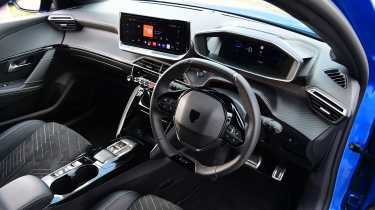
|
Pros |
|
|
Cons |
|
The Peugeot 208 has been designed to charm a new generation of customers. Inside and out, the approach is eye-catching, and the quality of the interior is equally impressive.
The cheapest Style specification includes 16-inch steel wheels with covers, an alarm, automatic lights and wipers, climate control, Bluetooth, a DAB radio and rear parking sensors.
Upgrading to mid-range Allure trim adds a 10-inch central touchscreen with Apple CarPlay and Android Auto smartphone connectivity, front parking sensors, an auto-dimming rearview mirror, privacy glass and an acoustic windscreen to reduce noise.
Moving up to GT spec brings in 17-inch alloy wheels, upgraded LED headlights, eight-colour ambient lighting, plus a 180-degree colour reversing camera. Opting for the range-topping GT Premium adds extra goodies such as Alcantara seats and multiple technology packs that’d otherwise be optional extras.
Interior and dashboard design
The latest 208 uses a revised version of Peugeot’s i-Cockpit set-up, but we still think it won’t suit everyone. Rather than looking through the steering wheel, the 208 has a much smaller wheel you must look over to see vital information, like your speed. We recommend you try the set-up for yourself to ensure you can find a comfortable driving position and still see all the info on the dash.
This digital display is similar (in theory) to the Audi Virtual Cockpit, which is available in the Audi A1. Switching between screens in the 208 isn’t as easy as in an Audi, and some people may find the layout takes a bit of getting used to.
Materials and build quality
Aside from some hard plastics on the doors and glovebox lid, along with the piano black plastic that seems to highlight every fingerprint and light scratch, the dashboard has plenty of soft-touch materials, and it feels well put together. There are also many nice design details, like contrast stitching and configurable ambient lighting.
Infotainment, sat-nav and stereo
All models receive Bluetooth, a DAB radio, and wireless Apple CarPlay and Android Auto smartphone connectivity, and a six-speaker sound system. At the centre of the dash resides an HD screen that looks snazzy but can be fiddly to use. During testing, we found Peugeot’s software far more complex to navigate compared to rivals like the SEAT Ibiza and Volkswagen Polo.
“Multi-coloured ambient lighting can’t prevent this car’s cabin from feeling dark. Blame the small windows all round – a worthwhile side effect of vastly improved crash protection, but one that also limits rearward visibility to the point where a reversing camera becomes a vital feature.” - Alex Ingram, chief reviewer
Boot space & practicality
Pros |
Cons |
|
|
The Peugeot 208 is offered exclusively as a five-door hatchback; unlike some rivals like the MINI Cooper, which offer the choice of three. Space inside the 208 is adequate, but those who are six feet in height or taller may feel a little snug in the back.
For 208 drivers, visibility over the shoulder and out of the back is a little restricted – a particular bugbear around town. You get standard-fit reverse parking sensors, but you’ll need to spring for an Allure to get sensors at the front, and a GT for a colour reversing camera.
Adding Peugeot’s Parking Pack will give you blind spot monitoring to warn you of approaching traffic alongside you on the motorway and help alleviate over-the-shoulder visibility issues, while adding the same pack to a GT trim adds an additional front camera to supplement the rearview camera. That’s good, but not quite as comprehensive as the 360-degree camera system available on Trophy versions of MG4.
Then there’s the Peugeot i-Cockpit driving position, which features the dials set high on the dashboard, and a small steering wheel you need to look over to see those dials. The wheel must be set low; otherwise, the rim obscures important driving information, such as the speed you’re going. If you're tall, that can place the wheel virtually in your lap, making for an awkward driving position. Some people won't have a problem, but others might, so it's well worth trying before you buy.
| Dimensions | |
| Length | 4,055mm |
| Width | 1,765mm |
| Height | 1,430mm |
| Number of seats | 5 |
| Boot space | 352-1,163 litres (208), 309-1,118 litres (E-208) |
Dimensions and size
As we’ve said, Peugeot only offers the 208 as a five-door model – it’s 4,055mm long, 1,765mm wide and 1,430mm tall. These are reasonably compact dimensions, and they come at a cost. The Peugeot 208’s closest rival, the Renault Clio, incorporates a longer wheelbase that provides more interior space for the driver and (in particular) rear passengers.
Driving position, seats & space in the front
Although it’s one of the smaller cars in the modern supermini class, the Peugeot 208 does provide a reasonable amount of space in the front, even for taller passengers. There’s just enough room to stretch out comfortably, and useful storage cubbies help to keep any space-obstructing clutter at bay.

Seats & space in the back
The 208’s CMP architecture isn’t as well packaged as the platform used by the Renault Clio, because it feels more cramped in the rear of the 208, and there’s not as much legroom. Accessing the rear isn’t as easy as it could be, with a small opening being particularly awkward for anyone putting a child into their car seat. The rear seats fold in a 60:40 configuration if required, and every model comes with two ISOFIX mounting points provided on the outer positions.
Boot space
Boot space in petrol and mild-hybrid versions of the 208 is respectable at 352 litres, which is one litre more than a Volkswagen Polo, and just under 30 litres shy of the 380 litres provided in the more generous Skoda Fabia. Like the Fabia, the 208 has a significant load lip to heave hefty items over to load up the boot. Unlike the Fabia, you can’t add a variable height boot floor to the 208.
The electric E-208 loses a little space, dropping to 309 litres. Again, because there isn’t an adjustable height floor, you won’t be able to hide the charging cables, so they must live in a bag, taking up valuable boot space when not in use. If you need to carry longer items, folding the rear seats down expands the combustion 208's luggage capacity up to 1,163 litres. That’s not bad, but if you need greater hauling capabilities, consider the Honda Jazz, which offers 1,205 litres of capacity and seats that fold flat into the floor.
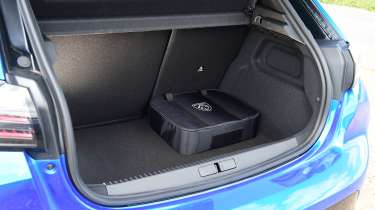
Towing
Both the petrol and mild-hybrid 208s are rated to tow up to 1,200kg braked. This is 300kg more than the Renault Clio. A tow bar is optional on all four trim levels.
“The five-door layout makes access easier than with a three-door car, but once inside, the 208’s rear space isn’t as its overall length might lead you to believe.” - Alex Ingram, chief reviewer.
Reliability & safety
|
Pros |
|
|
Cons |
|
The Peugeot 208 finished as the 50th best car to own out of 50 cars in the 2025 Driver Power satisfaction survey, which placed it below key rivals such as the Renault Clio, Toyota Yaris and even the closely related Vauxhall Corsa. Owners did praise the 208’s design and driving experience, but there were gripes with areas including servicing costs and quality. Peugeot itself did put on a decent performance in our most recent best manufacturer rankings, though, where it placed sixth out of 32 brands.
In terms of safety, the previous-generation 208 achieved the maximum five-star Euro NCAP rating – albeit under a less stringent testing procedure – but the current 208 was only awarded a four-star rating in 2019. Criticism was noted for poor whiplash protection for rear seat occupants. Originally, the autonomous emergency braking (AEB) system fitted as standard to all 208 models couldn’t recognise pedestrians and cyclists that well at night. Thankfully, though, this has since been upgraded to the brand’s Active Safety Brake system, and this remains fully functional around the clock.
All cars get six airbags, lane-keeping assist to help keep you in your lane on the motorway, a speed limit recognition system to (hopefully) keep you from breaking the speed limit, a tyre pressure monitoring system to warn you of possible punctures and a stability control system. As mentioned in the interior section, it’s possible to get a blind spot monitoring system if you add the Parking Pack, and this will alert you about any vehicles that appear alongside you.
It is a shame that you must pay extra for adaptive cruise control (a system that maintains a safe distance from the car in front of you), which is standard on the MG4.
| Key standard safety features |
|
| Euro NCAP safety ratings |
|
Buying and owning
Our best buy: Peugeot 208 1.2 PureTech Allure
Although the mild-hybrid models offer a bit more power and efficiency, the petrol 208 still offers reasonably low running costs as well as cutting the starting price by quite a significant amount. Forking out a little bit more for the Allure trim will add some useful features such as an electronic parking brake. This car looks a bit sportier than the entry-level style, too, with alloy wheels and privacy glass.
However, if you’re looking at the 208 as a potential company car, you’ll be better served by the electric E-208 due to the significantly lower Benefit-in-Kind tax.
Peugeot 208 alternatives
The Peugeot 208 can safely be described as a stylish French supermini, but there’s another car that also matches this description; the Renault Clio. Just like the 208, the Clio also offers the choice of petrol or hybrid power, along with some lower prices and running costs in places. There’s also Peugeot's Stellantis sibling, the Vauxhall Corsa, which is arguably less fashionable than the 208, but comes with prices that tend to be just that bit lower.
Latest deals on the 208 and rivals
Peugeot 208 history
The timeline of the Peugeot 208 begins back in 2012, and covers two generations at the time of writing. Both models have affordable running costs to their name, and prices have been kept in check by their popularity, although the 208 Mk2’s improvements over the Mk1 model in areas like interior quality and equipment make it a more desirable and, therefore, more expensive buy. There have been some reliability concerns in the past with the MK1 208, and the current MK2 certainly isn’t proving to be as dependable as rivals such as the Honda Jazz or Toyota Yaris.
Peugeot 208 Mk2: 2019-present
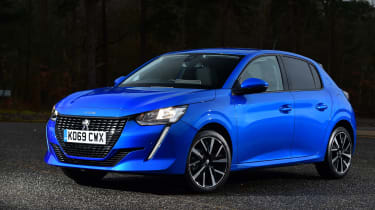
Rather than naming its new-gen supermini the 209, Peugeot decided to instead do a second generation of 208. The similarities go beyond the name, too: like its predecessor, the 208 Mk2 has a distinctive design and a broad selection of engines – including an array of petrols, a frugal diesel and for the first time on the Peugeot 208, a fully electric option. Unlike the 208 Mk1, the Peugeot 208 Mk2 is only available as a five-door hatchback, and the second-gen 208’s more premium billing meant it was a bit more expensive than the first-gen model.
Peugeot 208 Mk1: 2012-2019
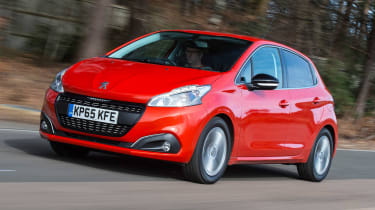
The Mk1 208 was a capable all-round supermini when new, and was a noticeable improvement over its predecessor, the Peugeot 207. Despite being shorter than the 207, the Peugeot 208 Mk1 was actually a bit roomier for passengers, and the car looked quite stylish inside and out. All Peugeot 208 Mk1s came with the more minimalist i-Cockpit dashboard design that debuted on this model, and most versions were well equipped, though bear in mind entry-level cars didn’t get a touchscreen display or Apple CarPlay and Android Auto smartphone connectivity. Read our full Mk1 Peugeot 208 buyer’s guide here…
Frequently Asked Questions
The Peugeot 208 is a good-looking car, and the petrol and mild-hybrid options will be economical. It’s also good to get an electric alternative, which is impressive in a shrinking supermini market. It is pricey, though, and not particularly spacious inside.
New & used Peugeot 208 deals
